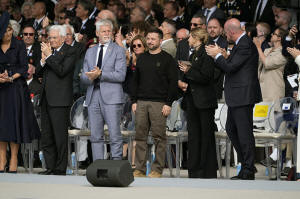Europe quietly works on a plan to send troops to Ukraine for post-war
security
 Send a link to a friend
Send a link to a friend
 [February 15, 2025]
By LORNE COOK [February 15, 2025]
By LORNE COOK
BRUSSELS (AP) — Increasingly alarmed that U.S. security priorities lie
elsewhere, a group of European countries has been quietly working on a
plan to send troops into Ukraine to help enforce any future peace
settlement with Russia.
Britain and France are at the forefront of the effort, though details
remain scarce. The countries involved in the discussions are reluctant
to tip their hand and give Russian President Vladimir Putin an edge
should he agree to negotiate an end to the war he launched three years
ago.
What is clear is that Ukraine's President Volodymyr Zelenskyy needs a
guarantee that his country's security will be assured until peace takes
hold. The best protection would be the NATO membership that Ukraine has
long been promised, but the U.S. has taken that option off the table.
“I won’t get into the particular capabilities, but I do accept that if
there is peace then there needs to be some sort of security guarantee
for Ukraine and the U.K. will play its part in that,” British Prime
Minister Keir Starmer said in cautious remarks on Thursday.
The Europeans began exploring what kind of force might be needed about a
year ago, but the sense of urgency has grown amid concern that U.S.
President Donald Trump might go over their heads, and possibly even
Ukraine’s, to clinch a deal with Putin.
Many questions remain unanswered but one stands out: what role, if any,
might the United States play?

European powers consider the road ahead
In December, after Trump was elected but before he took office, a group
of leaders and ministers huddled with Zelenskyy at NATO
Secretary-General Mark Rutte’s residence in Brussels. They came from
Britain, Denmark, France, Germany, Italy, the Netherlands and Poland.
Top European Union officials attended too.
The talks built on an idea promoted by French President Emmanuel Macron
in early 2024. At the time his refusal to rule out putting troops on the
ground in Ukraine prompted an outcry, notably from the leaders of
Germany and Poland.
Macron appeared isolated on the European stage, but his plan has gained
traction since.
Still, much about what the force might look like and who will take part
will depend on the terms of any peace settlement, and more.
Italy has constitutional limits on the use of its forces. The
Netherlands would need a greenlight from its parliament, as would
Germany, whose position could evolve after the Feb. 23 elections usher
in a new government. Poland is cautious, given lingering animosities
with Ukraine that date from World War II.
“We are in a very early stage,” Hanno Pevklur, Estonia’s defense
minister told The Associated Press on the sidelines of the Munich
Security Conference.
While there are various ongoing discussions and rumors, it is “critical”
for European allies to understand what the contact line in Ukraine will
look like before coming up with a plan, Pevkur said.
If Russia and Ukraine reduce their forces along the front line to a
“couple of thousand” on both sides, then “it’s not a problem for Europe
to also be there,” Pevkur said, pointing out that it would be much
harder if there is still a “boiling conflict.”
A robust security force rather than peacekeepers
The makeup and role of the force will be dictated by the kind of peace
deal that’s reached. If Russia and Ukraine can agree terms as the
negotiations progress, it’s plausible that fewer security precautions
and a smaller force would be needed.
But experts and officials warn that, as things stand, the Europeans must
deploy a robust and sizeable contingent, rather than a team of
peacekeepers like United Nations “blue helmets.”
“It has to be a real force (so) that the Russians know that if they ever
tested it that they would get crushed. And you can be sure that Russia
will test it,” Ben Hodges, the former Commanding General of U.S. Army
Europe, said last month at a European Policy Centre think tank event.

[to top of second column]
|

Ukraine President Volodymyr Zelenskyy, center, and other
dignitaries, attend an international ceremony to mark the 80th
anniversary of D-Day, Thursday, June 6, 2024, in Normandy. (AP
Photo/Evan Vucci, File)

“They violate every single agreement. So if we send a force in
there, they’ve got to have airpower, large land forces, drones,
counter-drones, air and missile defense. All of that," he said. "If
they go in there with a bunch of blue helmets and rifles, they will
get crushed.”
Retired French Gen. Dominique Trinquand, a former head of France’s
military mission at the United Nations, agreed that U.N.
peacekeepers are better suited “for deployment in zones that are far
more stable."
“For starters, mounting this operation with soldiers taken from
across the world would take about a year,” he said.
There also needs to be training of Ukrainian soldiers and investment
in Ukraine’s defense industry, Latvia Defense Minister Andris Sprūds
told the AP.
How big a force?
The nature of the peace deal will determine the size and location of
the European contingent. Zelenskyy has insisted on at least 100,000
to 150,000 troops. Media reports have speculated about a
30,000-40,000 strong force. Diplomats and officials have not
confirmed either figure.
Ukraine also wants air support, not just boots on the ground.
What is clear is that the Europeans would struggle to muster a
large-scale force, and certainly could not do it quickly.
In an interview on Friday with the Financial Times, Macron said that
the idea of deploying a huge force is “far-fetched.”
“We have to do things that are appropriate, realistic, well thought,
measured and negotiated,” he said.
U.S. Defense Secretary Pete Hegseth insisted this week on “robust
international oversight of the line of contact,” a reference to the
roughly 1,000-kilometer (600-mile) long front line. The Europeans
are reluctant as that would require too many troops.
Nearly all agree that some kind of “American backstop” is essential.
European armed forces have long relied on superior U.S. logistics,
air transport and other military capabilities.

The U.S. lays down some rules
At NATO headquarters on Wednesday, Hegseth began describing the
terms under which the U.S. might agree to a force that would help
provide Ukraine with the “robust security guarantees to ensure that
the war will not begin again.”
“Any security guarantee must be backed by capable European and
non-European troops,” Hegseth told almost 50 of Ukraine’s Western
backers. If they go to Ukraine, he said, “they should be deployed as
part of a non-NATO mission.”
Putin has said that he launched the invasion in part due to NATO
territory expanding too close to Russia’s borders and is unlikely to
accept any operation run by the world’s biggest military
organization.
Any European allies taking part would not benefit from NATO’s
collective security guarantee if they were attacked, Hegseth said.
He underlined that “there will not be U.S. troops deployed to
Ukraine.”
He did not reveal what role the U.S. might play.
From Ukraine's perspective, a Europe-only operation simply would not
work. “Any security guarantees are impossible without the
Americans,” Ukrainian Foreign Minister Andrii Sybiha warned
Thursday.
___
Associated Press writers Emma Burrows in Munich, Germany and Angela
Charlton and John Leicester in Paris and Jill Lawless in London
contributed to this report.
All contents © copyright 2025 Associated Press. All rights reserved |